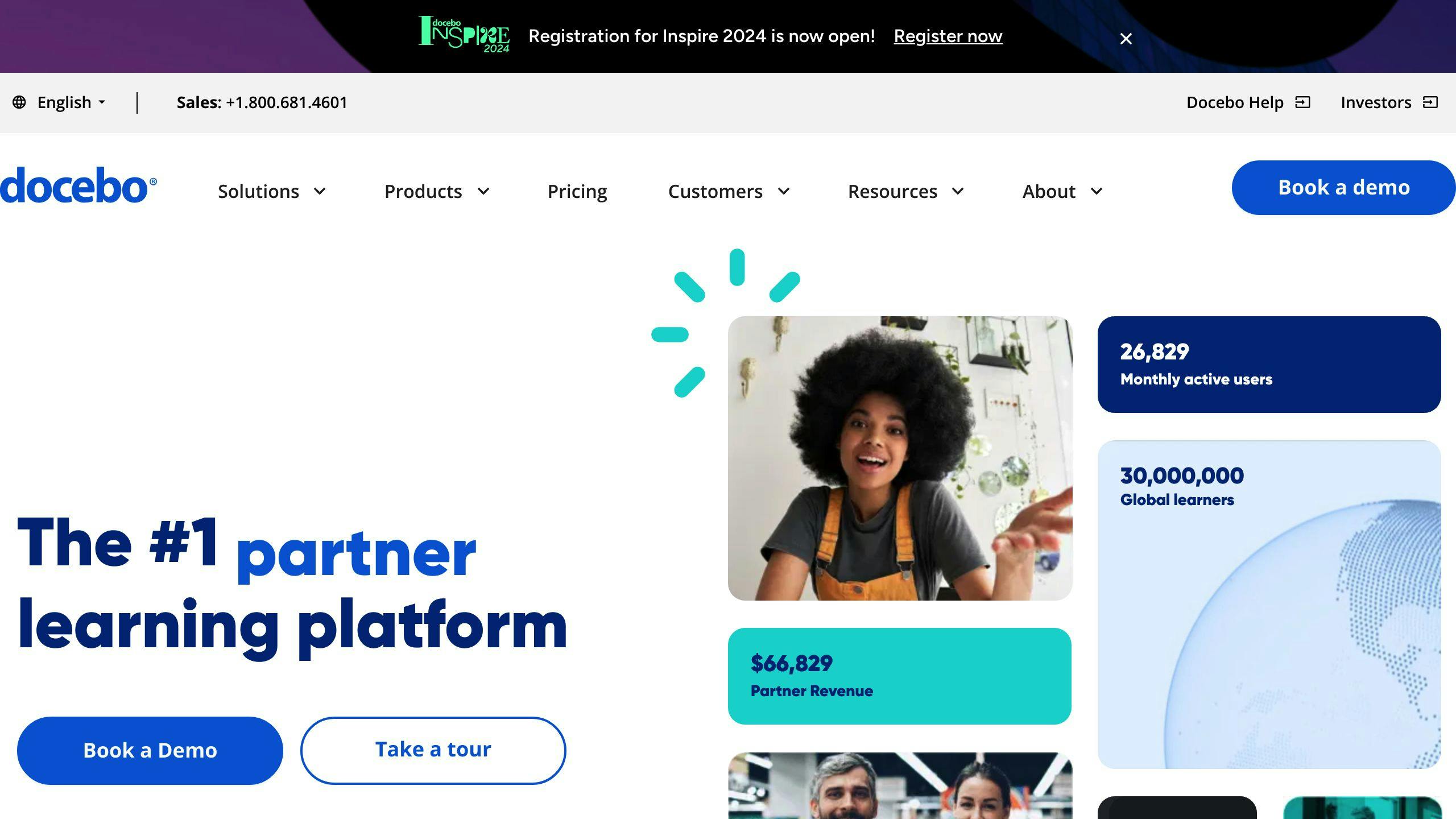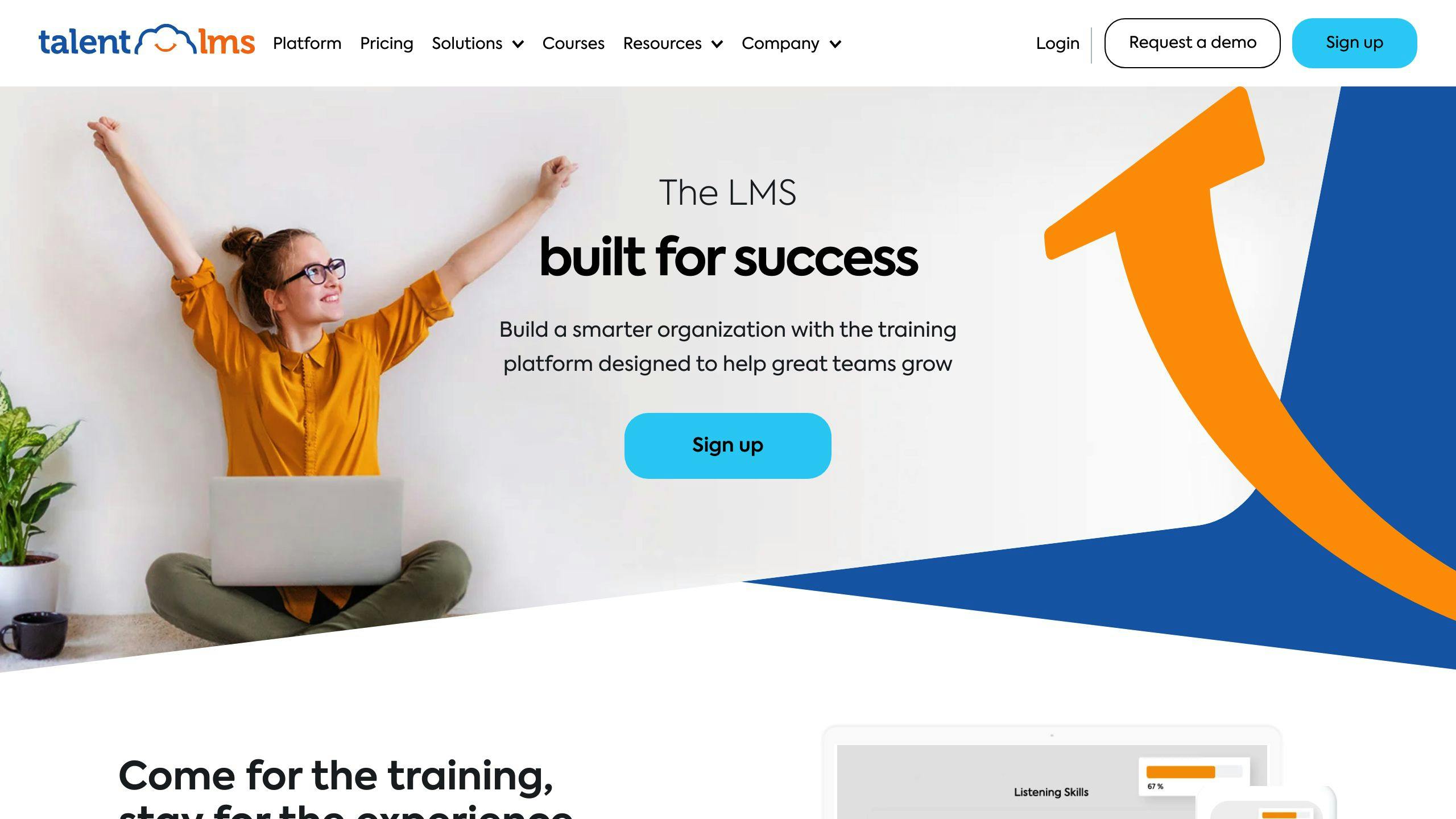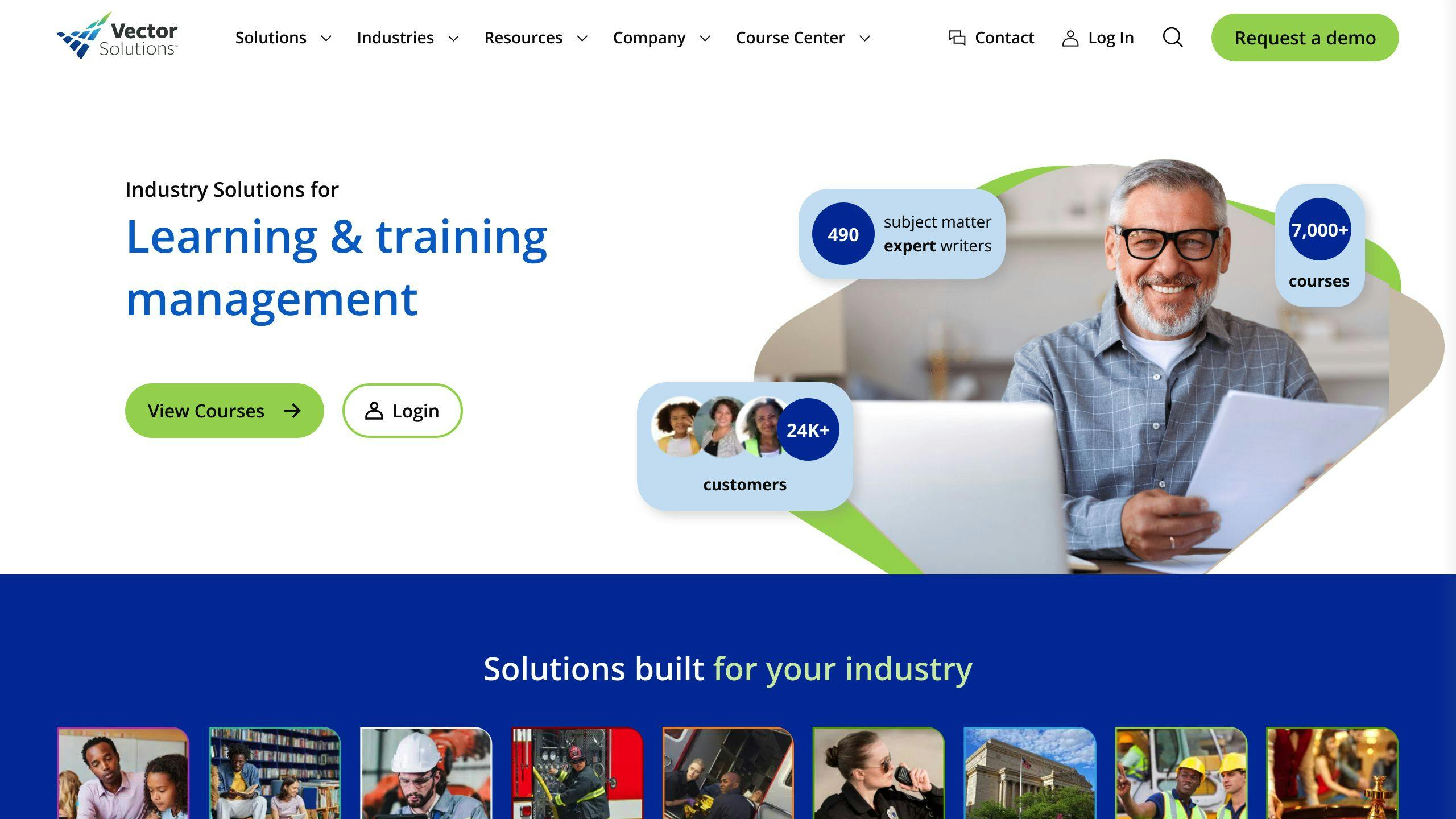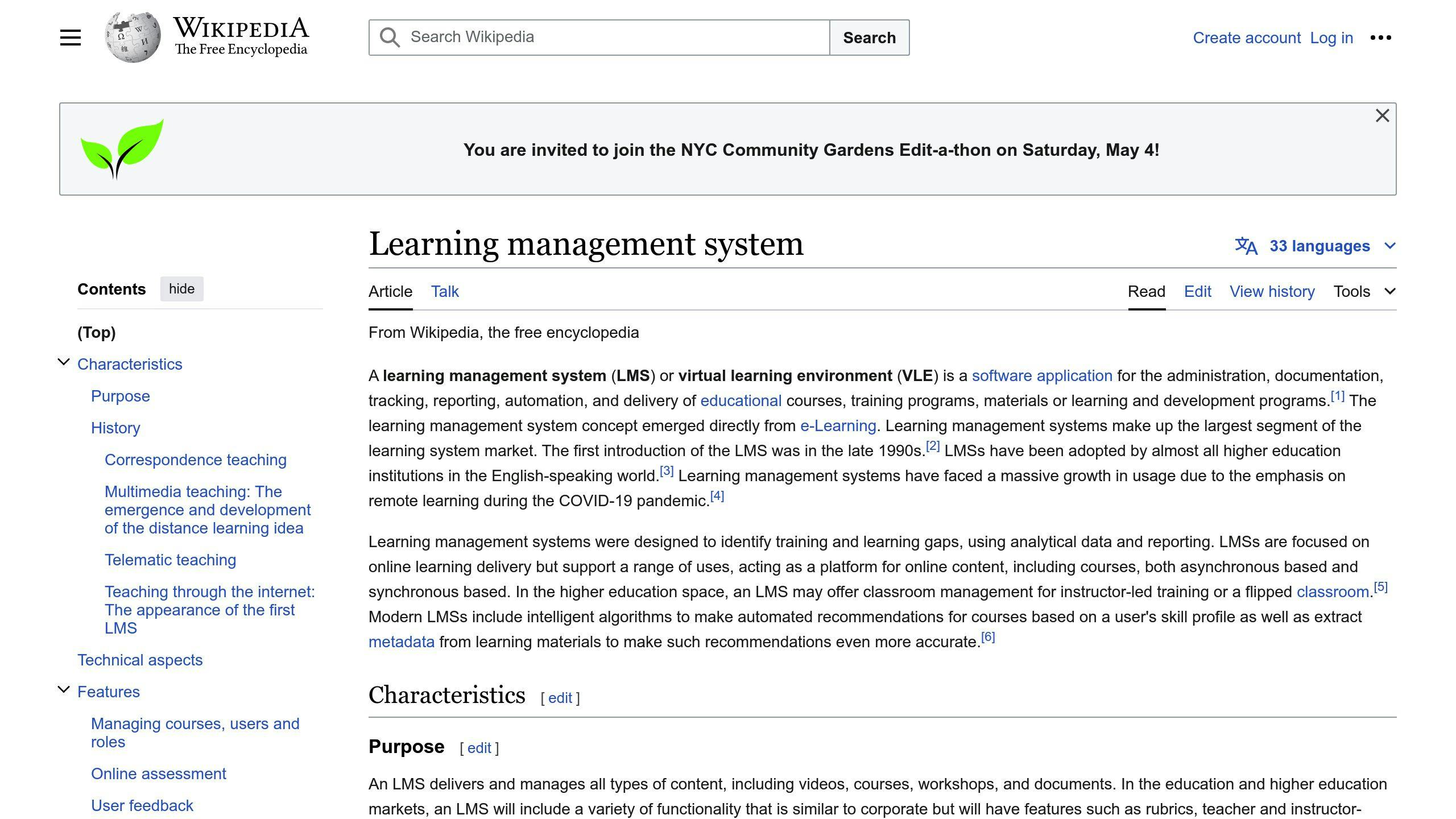Compliance training software educates employees on company policies, government regulations, and ethical guidelines. It automates training delivery, tracks progress, and ensures adherence to regulations, promoting a culture of safety, quality, and ethics within the organization.
Key Features:
- Content Management: Create and manage compliant training materials
- Training Management: Track employee progress and training schedules
- Training Delivery: Deliver training content to employees
- Certification: Provide certification upon completion of training
- Analytics: Track and analyze training data
Benefits:
- Enhanced Training Engagement
- Consistent Training Delivery
- Simplified Management of Compliance Records
Essential Training Management Tools:
| Tool | Description |
|---|---|
| Automated tracking | Track employee training progress, completion rates, and certification status |
| User-friendly interface | Intuitive interface for employees to access and complete training |
| Customizable reporting | Generate reports on training completion rates, certification status, and employee performance |
| Seamless integration | Integrate with existing HR systems like LMS and HCM |
Advanced Tools for User Engagement:
| Tool | Description |
|---|---|
| Personalized learning paths | Tailored learning paths based on individual needs and learning styles |
| Real-time data visualizations | Display real-time data to help understand complex topics and track progress |
| Interactive elements | Incorporate quizzes, games, and simulations for engaging training |
Types of Compliance Training Software:
- Learning Management Systems (LMS): Centralized platform for content management, automation, and reporting
- Specialized Compliance Training Systems: Industry-specific training content and regulations (e.g., HIPAA, GDPR)
Choosing the Right Software:
- Assess your compliance training needs
- Evaluate and compare vendors
- Prepare for software implementation
Leading Vendors:
- Docebo: Personalized learning paths, certification management, reporting and analytics
- TalentLMS: Automation, engaging training experiences, reporting and analytics
- Vector Solutions: Due date tracking, refresher training management, secure data retention
Improving Training Effectiveness:
- Create engaging training content (storytelling, interactive elements, varied formats)
- Measure success with metrics like completion rates, quiz scores, compliance incident rates, and employee feedback
Defining Compliance Training Software
Compliance training software is a digital tool that educates employees on company policies, government regulations, and industry-specific ethical guidelines. This software plays a crucial role in ensuring organizations meet regulatory requirements and maintain best practices for legal compliance.
Compliance and Risk Management
Compliance training software helps minimize risks and maintain ethical standards within businesses. By providing employees with the necessary knowledge and skills, organizations can reduce the risk of non-compliance, protect their reputation, avoid legal penalties, and maintain a positive work environment.
Benefits of Compliance Training Platforms
Compliance training software offers several benefits:
| Benefit | Description |
|---|---|
| Enhanced Training Engagement | Makes training more engaging and interactive, leading to better knowledge retention and a more informed workforce. |
| Consistent Training Delivery | Ensures training is delivered consistently across the organization, reducing the risk of non-compliance. |
| Simplified Management of Compliance Records | Streamlines the management of compliance records, making it easier to track employee training and certification. |
By leveraging compliance training software, organizations can create a culture of compliance and reduce the risk of non-compliance. In the next section, we will explore the key features of compliance training software in more detail.
Key Features of Compliance Training Software
Compliance training software is designed to provide organizations with the necessary tools to educate employees on company policies, government regulations, and industry-specific ethical guidelines. When selecting a compliance training software, HR professionals should look for key features that meet the needs of modern organizations.
Essential Training Management Tools
Effective compliance training software should include essential training management tools that streamline the training process, ensure consistency, and reduce the risk of non-compliance. These tools include:
| Tool | Description |
|---|---|
| Automated tracking | Track employee training progress, completion rates, and certification status automatically. |
| User-friendly interface | Provide an intuitive interface that makes it easy for employees to access and complete training modules. |
| Customizable reporting | Generate reports that meet the organization's specific needs, including training completion rates, certification status, and employee performance. |
| Seamless integration | Integrate with existing HR systems, such as learning management systems (LMS) and human capital management (HCM) systems. |
Advanced Tools for User Engagement
To enhance user experience and learning outcomes, compliance training software should include advanced tools that promote engagement and interactivity. These tools include:
| Tool | Description |
|---|---|
| Personalized learning paths | Provide learning paths tailored to individual employee needs and learning styles. |
| Real-time data visualizations | Display real-time data visualizations to help employees understand complex compliance topics and track their progress. |
| Interactive elements | Incorporate interactive elements, such as quizzes, games, and simulations, to make compliance training more engaging and interactive. |
By including these essential and advanced features, compliance training software can help organizations create a culture of compliance, reduce the risk of non-compliance, and improve overall employee performance.
Types of Compliance Training Software
Compliance training software comes in different forms, each catering to specific organizational needs and industries. Understanding the different types of compliance training software is crucial for HR professionals to choose the most suitable platform for their organization.
Learning Management Systems for Compliance
Learning Management Systems (LMS) designed for compliance training offer a centralized platform for content management, automation, and reporting. These systems enable organizations to create, assign, and track compliance training programs efficiently.
| Feature | Description |
|---|---|
| Content Management | Create and manage compliant training materials |
| Automation | Automate training delivery and tracking |
| Reporting | Generate reports on training completion and certification |
For instance, Docebo's LMS provides a comprehensive compliance training solution with features like automated tracking, customizable reporting, and seamless integration with existing HR systems.
Specialized Compliance Training Systems
Some compliance training platforms are designed to support adherence to specific regulations, such as HIPAA or GDPR. These specialized systems provide industry-specific training content, ensuring organizations meet the required standards and regulations.
| Regulation | Description |
|---|---|
| HIPAA | Healthcare organizations: patient data protection, confidentiality, and security protocols |
| GDPR | Financial institutions: data protection and privacy regulations |
By understanding the different types of compliance training software, HR professionals can select the most suitable platform for their organization's specific needs, ensuring effective compliance training and minimizing the risk of non-compliance.
Choosing the Right Compliance Training Software
Selecting the right compliance training software is crucial for HR professionals. With many options available, it's essential to have a structured approach to identify, evaluate, and implement the right solution that aligns with organizational goals and budget.
Assessing Your Compliance Training Needs
Before selecting a compliance training software, identify your organization's unique requirements. Set clear objectives, such as reducing the risk of non-compliance, improving employee engagement, or streamlining training processes. Consider the following factors:
| Factor | Description |
|---|---|
| Industry-specific regulations and standards | Identify relevant regulations and standards for your industry |
| Employee roles and responsibilities | Determine the training needs of different employee roles |
| Training content and format preferences | Decide on the type of training content and format that suits your organization |
| Budget and resource constraints | Establish a budget and resource allocation for compliance training |
| Integration with existing HR systems | Consider the need for integration with existing HR systems |
By understanding your organization's needs, you can create a comprehensive list of must-have features for your compliance training program.
Evaluating and Comparing Vendors
Research vendors and analyze the pros and cons of each. Consider factors such as:
| Factor | Description |
|---|---|
| Compliance expertise and industry knowledge | Evaluate the vendor's expertise in compliance training |
| Customization options and flexibility | Determine the level of customization and flexibility offered |
| User experience and engagement features | Assess the user experience and engagement features |
| Reporting and analytics capabilities | Evaluate the reporting and analytics capabilities |
| Integration with HR systems and other tools | Consider the integration options with HR systems and other tools |
| Customer support and training resources | Evaluate the customer support and training resources |
Create a comparison matrix to visualize the strengths and weaknesses of each vendor.
Preparing for Software Implementation
Once you've selected a vendor, prepare for software implementation. Ensure that you have a clear understanding of the implementation process, including:
| Step | Description |
|---|---|
| Timeline and milestones | Establish a timeline and milestones for implementation |
| Training and support resources | Determine the training and support resources needed |
| Data migration and integration requirements | Identify data migration and integration requirements |
| Change management and communication strategies | Develop change management and communication strategies |
| Ongoing maintenance and updates | Plan for ongoing maintenance and updates |
By prioritizing vendor support during and after implementation, you can ensure a smooth transition and maximize the ROI of your compliance training software.
By following this structured approach, you can choose the right compliance training software that meets your organization's unique needs and goals, minimizing the risk of non-compliance and improving overall training effectiveness.
sbb-itb-d78b90b
Leading Compliance Training Software Reviews
In this section, we'll review leading compliance training software vendors, comparing their features to help HR professionals make informed decisions.
Docebo for Compliance Training

Docebo is a popular learning management system (LMS) that offers a comprehensive suite of compliance training tools. Its key features include:
| Feature | Description |
|---|---|
| Personalized Learning Paths | AI-powered learning paths tailored to individual employee needs |
| Certification Management | Automated certification tracking and renewal reminders |
| Reporting and Analytics | Detailed reports and analytics to track employee progress and compliance |
TalentLMS for Compliance Training

TalentLMS is another prominent LMS that offers a range of features specifically designed for compliance training. Its key features include:
| Feature | Description |
|---|---|
| Automation | Automate compliance training, certification, and reporting processes |
| Engaging Training Experiences | Interactive and immersive training content to boost employee engagement |
| Reporting and Analytics | Detailed reports and analytics to track employee progress and compliance |
Vector Solutions for Compliance Training

Vector Solutions is a compliance training software that offers a range of features specifically designed to meet the unique needs of compliance training. Its key features include:
| Feature | Description |
|---|---|
| Due Date Tracking | Automated tracking and reminders for compliance training deadlines |
| Refresher Training Management | Easy management of refresher training and certification renewal |
| Secure Data Retention | Secure storage and retention of compliance training data |
By evaluating these leading compliance training software vendors, HR professionals can make informed decisions about the best solution for their organization's unique compliance training needs.
Improving Compliance Training Effectiveness
Effective compliance training is crucial for organizations to maintain a culture of integrity and avoid costly penalties. In this section, we'll discuss strategies for leveraging compliance training software to cultivate a culture of continuous learning and compliance.
Creating Engaging Training Content
To make compliance training more engaging and effective, consider the following tips:
| Tip | Description |
|---|---|
| Use storytelling | Share real-life examples or scenarios that illustrate the importance of compliance in the workplace. |
| Keep it short and sweet | Break down complex topics into bite-sized chunks, using multimedia elements like videos, images, and quizzes to keep employees engaged. |
| Make it interactive | Incorporate gamification, role-playing, or scenario-based training to encourage active participation and application of compliance knowledge. |
| Use varied content formats | Offer a range of training content, including online courses, workshops, and in-person training sessions, to cater to different learning styles. |
Measuring Training Program Success
To ensure the effectiveness of your compliance training program, track the following key metrics:
| Metric | Description |
|---|---|
| Training completion rates | Monitor the percentage of employees who complete compliance training modules within a specified timeframe. |
| Quiz and assessment scores | Track employee performance on quizzes and assessments to identify knowledge gaps and areas for improvement. |
| Compliance incident rates | Analyze the number of compliance incidents or breaches reported before and after implementing compliance training to measure its impact on reducing risk. |
| Employee feedback and engagement | Collect feedback from employees on the training content, format, and overall experience to identify areas for improvement and increase engagement. |
By implementing these strategies, organizations can create an effective compliance training program that fosters a culture of continuous learning and compliance, ultimately reducing the risk of non-compliance and promoting a positive work environment.
Conclusion: Choosing Compliance Training Software
Selecting the right compliance training software is crucial for maintaining a culture of integrity and avoiding costly penalties. Throughout this guide, we've discussed the key factors to consider when choosing a compliance training platform.
Key Considerations for Software Selection
When evaluating compliance training software, consider the following essential factors:
| Factor | Description |
|---|---|
| Customization | Can the platform be tailored to meet your organization's specific compliance training needs? |
| User Engagement | Does the platform offer features that encourage employee participation and engagement? |
| Reporting and Analytics | Can the platform provide detailed reports and analytics to track employee progress and measure training effectiveness? |
| Integration | Does the platform integrate seamlessly with your existing HR systems and tools? |
| Support and Customer Service | What level of support and customer service does the vendor offer? |
Tips for Compliance Training Success
To ensure the success of your compliance training program, remember the following tips:
- Align your compliance training program with your organization's goals and values.
- Make compliance training a continuous process to ensure employees remain up-to-date on changing regulations and industry standards.
- Encourage employee feedback and engagement to identify areas for improvement and increase training effectiveness.
- Monitor and track employee progress to identify knowledge gaps and provide targeted training and support.
- Stay up-to-date with changing regulations and industry standards to ensure your compliance training program remains relevant and effective.
By considering these key factors and following these tips, you can choose a compliance training software that meets your organization's unique needs and helps you maintain a culture of compliance and integrity.
FAQs
What is compliance training software?
Compliance training software is a tool that helps businesses educate employees on company policies, industry regulations, and ethical guidelines. It makes training delivery more efficient, ensures adherence to regulations, and promotes a culture of safety, quality, and ethics within the organization.
Can an LMS accommodate different industry-specific compliance requirements?

| Industry | Compliance Requirements |
|---|---|
| Healthcare | HIPAA, patient data protection |
| Finance | GDPR, data protection and privacy |
| Manufacturing | OSHA, workplace safety |
Yes, a flexible LMS can be modified to fit the particular compliance requirements of various businesses.
How often is compliance training required?
Compliance training is typically required annually, but some topics may require more frequent training. Automation features can be set up to remind employees when they are due for compliance training.
What should compliance training include?
Compliance training should cover:
- Company policies and procedures
- Code of conduct
- Industry-specific laws and regulations
- Anti-harassment training
- Workplace safety
- Diversity training
Why is compliance training important?
Compliance training is important because it helps companies:
- Mitigate risk
- Ensure workplace safety
- Create a more inclusive workplace
- Avoid costly fines and legal action
- Maintain a positive reputation


